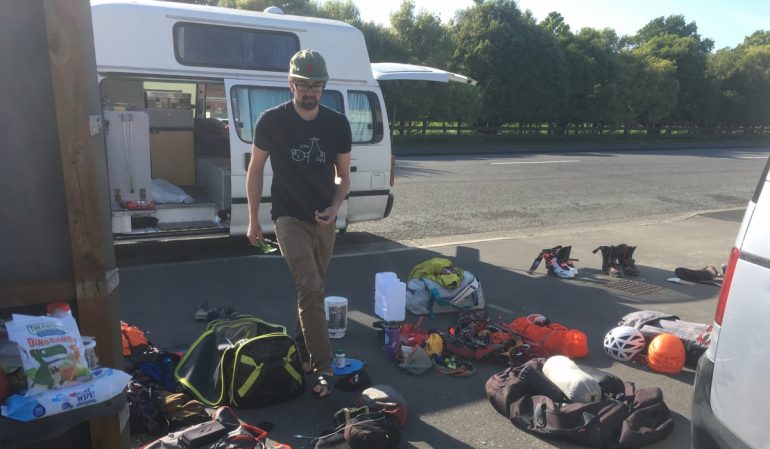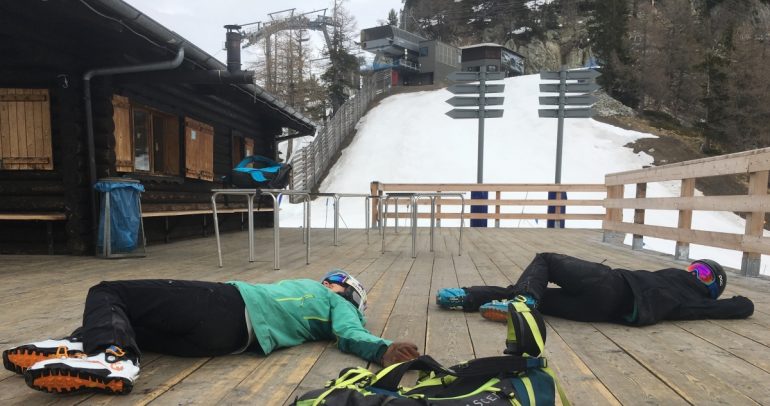Tips for booking tickets, packing and schlepping your gear
“No, you can not bring your ski boots on the plane,” the employee behind the Norwegian Air desk at the Paris Airport informed Louie and me. “They have metal buckles on them.” We had just watched our checked luggage disappear on the luggage carousel. Louie and I exchanged surprised looks, what?! We were on a ski trip to Norway and throughout all of the other ski trips we’ve taken, hadn’t encountered this rule about ski boots.
We then had to wrap our ski boots in this plastic contraption and pad them with what we had in our carry on. The desk agent also wanted us to pay $200 for the “extra bag” (we had just checked our extra bag…). I was somewhere between wanting to jump him from the other side of the counter to breaking down crying. Maybe he felt the inner power in me, and after an intense back-and-forth stare between us, he decided he would spare the charge. Our boots made it to Norway unscathed and the Norwegian Air employee in Tromso didn’t care about the metal buckles on our flight home.
Over the past year, Louie and I have been fortunate to explore mountains around the world. We have visited New Zealand, Japan, Norway, Chamonix and British Columbia. Our travel styles and expectations don’t always align, as Louie is a lot better at dealing with uncertainty and winging it. I gravitate towards predictability and structure to reduce the possibility of disarray. I’d be lying if I told you I have successfully escaped the stress of travel. As we approach the holiday and winter travel season, here are a few tips that have made me feel less helpless when I feel chaotic energy of travel taking over.
Skiing is one of the most condition-dependent sports out there. Being open to changing your plan is key. The reality is, you’ll probably spend too much time picking your destination, packing and stressing. Once you arrive you might have to deal with unexpected rain, more non-ski days then ski days, and unforeseen logistical complications. Stay calm and just go with it.
Deciding on your trip destination can be difficult and Instagram sure doesn’t help with everyone posting about their epic adventures all over. The “Instagram snow report” is notoriously unreliable. You may have heard that Japan tends to have heavenly pow in January, Chamonix is an amazing early spring ski destination, New Zealand tends to have good skiing in spring as well (just don’t forget that’s in October). The way Louie and I have made our decisions has been based on researching the places that we’d like to explore on skis and making a list of objectives we are both psyched on. Then we hope for the best when we get there.
Booking tickets
First, the more exciting part of travel – booking tickets. A few things to consider:
Time to buy. Generally, buying ~6 months before the trip guarantees the cheapest cost but it’s hard to predict conditions six months ahead of time. Airline miles or credit card points can be helpful if you want to buy closer to the date of your trip.
Time difference. When traveling internationally, time change can ruin vacation enjoyment. Try to fly through the night to sleep on the plane and arrive in the morning. Or the opposite works too, arrive at night and try to not sleep on the plane, so you can crash once you get to your destination.
Layovers. It is true that flights with layovers are sometimes cheaper but weigh the difference between cost vs travel time. Layovers can also cause luggage delays, a big bummer when you’re sending your new skis halfway around the world.
Transportation. Traveling with ski bags can be difficult so plan ahead. Generally, renting a car is the easiest and gives you the most flexibility, but it often isn’t the cheapest. In NZ, we rented a van. In Japan, we used bullet trains and buses.
Travel Insurance. Make sure you get medical coverage when abroad. Review the plan carefully; travel insurance doesn’t have to just be medical, it can also help protect your airfare, lost luggage, etc. I have opted into only getting medical insurance and having the rest covered through my credit card. Do your research, read the fine print and figure out what works best for you, bottom line – make sure you are covered. Not all travel insurance covers remote medical evac and the American Alpine Club is worth checking out for more remote options. Also, some travel insurance considers skiing out of bounds an “extreme sport” and doesn’t cover it. I’ve used Travelguard in the past, and it’s worked well, even with covering “extreme skiing” injuries.
Travel Credit Card. If you plan to travel, I highly recommend taking a look at Chase Sapphire Reserve or a similar card. They provide free lounge access, excellent insurance coverage as well as airline points. Some cards offer sign on bonuses of 50,000 travel points or more, which could set you up for the next international trip too!
Now that you have your airfare booked and you are feeling psyched, it’s time to think about:
Accommodations If you book accommodations ahead of time, make sure there is a flexible cancellation policy. If weather drastically changes, you may need to adjust course. If you’re fairly sure that places won’t be fully booked last minute, then booking only a few days in advance and having the extra flexibility can be beneficial. Also, having the ability to car-camp in an area can add a lot of flexibility.
Pre-trip resources Find the best weather and avalanche forecast for the areas where you are going. We are blessed with amazing avalanche centers in the US, but not all places have the same streamlined resources. If you can’t seem to find what you are looking for, try starting your search with local alpine clubs. Pay attention to weather and avalanche forecasts from now until your trip; knowing the snowpack is key to making informed decisions once you arrive. For international weather, I tend to use yr and mountain forecast:
Packing
If you are like me, you have hopes and dreams to pack early and be ready a few days before your flight; in reality I’m always cramming at the last minute. I have constant envy of pretty, arranged gear photos, and have never been successful at anything better than a pile. It has helped me to divide packing into three parts.
Part 1: Hopelessly throwing everything I think I want to bring in a giant pile. This invariably involves a silly amount of time searching for some random, but necessary, item.
Part 2: Picking bags wisely
First, consider the cost of each bag. Most US airlines will let you bring one free bag. If you are traveling with a partner make that two. The next bag cost can be anywhere from $25 to $100, so most of the time if you could have one less bag it will be to your benefit. Consolidate bags when you can. Louie and I have learned to travel with a ski bag that fits two pairs of skis and a large 90L duffel for luggage. For carry on we will bring a 40L duffel like the Patagonia Black Hole that can be carried as a backpack and a 45L pack. Make sure your carry-on fits the specifications, especially when traveling in Europe.
Bag weight. Most US airlines will limit bags at 50 pounds. The biggest lesson: usually that is just not enough weight for two people’s worth of backcountry gear. We always travel with a small hanging scale. It helps save lots of headaches when packing and repacking. Sometimes bags get magically heavier on the return flight.
Comfort for carrying. No matter if you are checking bags or if you are getting a car during your travel, you still will probably need to carry your bags more when you want. If you’re going to be using more public transportation, having bags that are easy to carry is key, sometimes having a big backpack instead of a duffel is a lifesaver.
Personal Item. Ski boots are the hardest piece of equipment to replace in the case of “lost luggage”. Eliminate this possibility by having them in your line of sight at all times. Don’t pack your boots. Instead, take them as your carry on “personal item” (as long as they aren’t too smelly).The only time an airline employee gave us grief about our boots was Norwegian Air story above. I think the guy was just having a bad day.
Bag Tags. Have your name, number and email on all your bags. Just in case anything is lost or forgotten, airport employees or good Samaritans will need your contact info.
Traveling with airbag backpacks. Remember that you cannot travel with most avalanche backpack cylinders when they are full. When we went to Japan we leveraged the Black Diamond Jet Force series, which has cylinders that you are allowed to fly with. We placed the cylinders in our luggage, with a print out rubber-banded to them describing what they are; the documents can be acquired on Black Diamond’s website. The backpacks were heavily inspected during one of the legs of our trips but for the most part we had no trouble bringing them on. Bottom line: do extra research if you plan to fly with an airbag backpack.
Part 3: Purge half of the pile made in Part 1 to make things fit. This involves a lot of heavy breathing, sighing and weighing of bags over and over again.
Part 4: The final packing. Be careful to protect any fragile items. In the ski bag, I like to pad the ski tips and bindings with durable items like gloves or skins. Often the most difficult item to pack is my helmet. It’s both fragile and bulky. I like to wrap it in a puffy jacket or other clothes, and put it in any bag but the ski bag. Best practice is to bring your beacon and any other fragile electronics (cameras, etc) inside your carry on.
Forgot something at home? Don’t stress. Some places will have what you need. But some won’t. It can be helpful to check for gear stores in the area ahead of time. Or you may have some amazing friends who may be willing to bring or ship items your way! Also, many travel insurance plans allow you to buy brand new gear to replace your lost stuff, even if it’s only delayed by a day. New skis? Awesome!
A few final thoughts
Trip Cost. Louie and I are big on saving cost where we can, as international trips can be expensive. We usually opt for the cheapest Airbnb or hostel we can find, and don’t mind spending the night on a friends floor, at a hut with minimal heat or snoozing in the car at the trailhead. We travel with sleeping pads and bags, which has proven to also be helpful for comfort if any airline delays get in our way. We try to cook instead of eating out. If conditions allow, we don’t buy lift tickets unless they have cheap one-ride tickets for access.
Explore local foods. Japanese ramen is a must. The French Alps are famous for various combinations of bread, potatoes and cheese.New Zealanders love their pies.
Make friends with the locals. We visit local shops to get beta for weather and what is skiing well. We also connect with our lodging hosts or other skiers we run into.
High hopes, low expectations. Did I mention weather has a mind of its own? Have a plan outside of just skiing so you can go explore if weather puts a wrench into your plan.
Have fun! Even with chaos, being able to explore new places around the world on skis is an unforgettable experience.
After a year of lots of travel, I am happy to have spent most of the summer and fall around the PNW involved in work and house projects. As I sit on my couch looking out at the rain hoping for snow in the mountains, I can’t wait to plan our next adventure. The chaos of travel sure has grown on me.
WildSnow Girl, Julia Dubinina, is a weekend warrior chasing snow in winter and sun in summer. A lover of long tours and steep skin tracks, she explores the Pacific Northwest and beyond. When she is not out adventuring, she is working away at her corporate desk job for a software company to make her next adventure happen.




